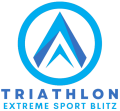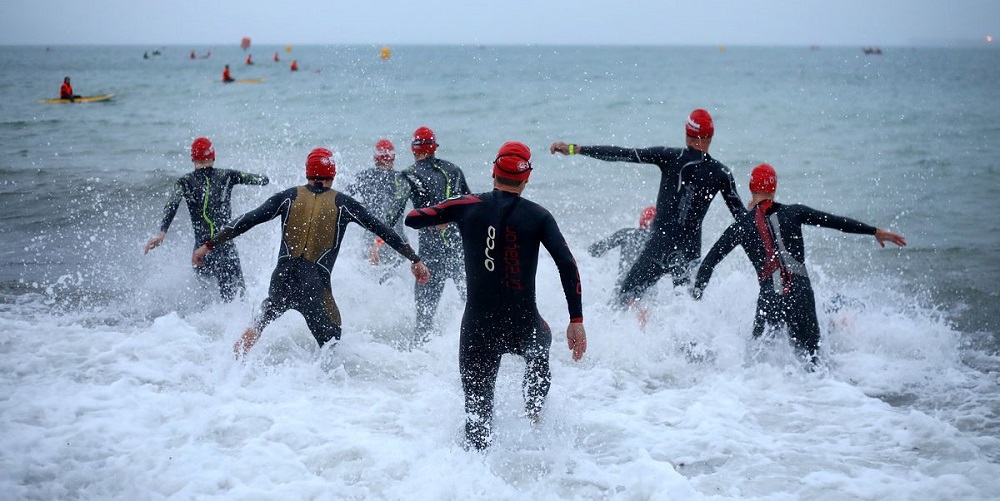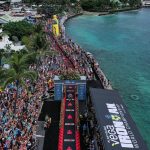As the sun peeked over the horizon, I stood at the starting line of my first half ironman. The crisp morning air filled my lungs as I anxiously surveyed the sea of athletes surrounding me. A mix of excitement and fear coursed through my veins, knowing that in just a few short hours, I would be pushing my mind and body to their limits.
Completing a half ironman is no simple task. It demands months of grueling training, unwavering mental strength, and sheer determination. Yet even with all that preparation, race day can bring unexpected challenges that test your physical and mental fortitude in ways you never imagined.
So, how hard is a half ironman?
A Half Ironman, also known as an Ironman 70.3, is a challenging endurance event that requires serious training and preparation. It consists of a 1900m swim, a 90km bike ride, and a half marathon.
The difficulty of a Half Ironman can vary greatly depending on your fitness level, experience, and goals. If your goal is simply to finish, you might need a minimum of six months to prepare. However, if you aim to perform at your best, you might need up to 12 months or even longer.
The weekly training volume can range from eight to twenty hours, depending on your goals and how your body responds to training. The training consists of a mixture of swim, bike, and run sessions each week, with long rides, long runs, and brick sessions at the weekend.
It’s important to note that while the race itself is broken down into 2% swim, 79% bike, and 19% run, many people make the mistake of neglecting their swim development. Investing time in swim training can pay dividends on race day.
In terms of average finishing times, for age-group triathletes, it’s 5:51 for men and 6:18 for women. Most triathletes finish a half-iron or 70.3 triathlon between 5 and 8 hours.
Table of Contents
A Beginner’s Guide to Half-Ironman
The half Ironman and the full Ironman are the two main types of Ironman races for people. These versions have different distances and levels of complexity. A 70.3 triathlon, which is another name for a half Ironman, has a 1.2-mile swim, a 56-mile bike ride, and a 13.1-mile run. The full IronMan, on the other hand, has a 2.4-mile swim, a 112-mile bike ride, and a 26.2-mile marathon run.
For people who are new to triathlons, the half Ironman may seem easier to do than the full Ironman because it is shorter. Take that as a warning, though: this event is not at all simple. The lengths are still tough, and the course is still difficult. To successfully finish, you need to train and prepare well.
Because the distances are different, the workout plans are also different. For a half Ironman, beginners will need less time to train than for a full Ironman. There must, however, be regularity and effort in training to build stamina and power for each sport.
In both sports, you have to be mentally as well as physically tough. A full Ironman can test an athlete’s mental strength to the limit. On the other hand, a half Ironman may seem easier for first-timers.
What is an IRONMAN 70.3?
An IRONMAN 70.3 is a half distance triathlon event that covers 70.3 miles (113 km) and includes a 1.2-mile (1.9 km) swim, a 56-mile (90 km) bike ride, and a 13.1-mile (21.1 km) run to finish. This event is named “70.3” as it is half the distance of each segment in a full IRONMAN race.
However, do not let the shorter distance deceive you, as IRONMAN 70.3 races are equally challenging and require proper training and preparation.
| Segment | IRONMAN | IRONMAN 70.3 |
| Swim | 2.4 miles (3.9 km) | 1.2 miles (1.9 km) |
| Bike | 112 miles (180 km) | 56 miles (90 km) |
| Run | 26.2 miles (42.2 km) | 13.1 miles (21.1 km) |
| Total Distance | 140.6 miles (226 km) | 70.3 miles (113 km) |
As depicted in the table above, an IRONMAN 70.3 race covers half the distance of each segment compared to a full IRONMAN race. However, don’t let this fool you, as both events require athletes to push their physical and mental limits, making them equally tough challenges.
While some may see IRONMAN 70.3 races as a stepping stone to the full IRONMAN distance, they should not be taken lightly. These races still require significant training and preparation, and the shorter distance means athletes must maintain a faster pace throughout. Additionally, IRONMAN 70.3 races are often held in challenging locations with varying terrain, adding to the difficulty of the course.
What to Expect Racing IRONMAN 70.3?
| Physical Challenges: | ||
| A demanding 1.2-mile open-water swim | – Can be challenging due to unpredictable waves and currents | |
| A 56-mile bike leg | – Requires strength, strategy, and pacing to conquer | |
| A half-marathon run of 13.1 miles | – Tests endurance and mental toughness | |
| Need for efficient technique, stamina, and mental composure in all three disciplines | ||
| Mental Challenges: | ||
| Staying committed to a rigorous training plan and trusting the process | ||
| Inclusive nature of IRONMAN 70.3 events attracting athletes from diverse backgrounds with varying levels of experience | – Can be daunting to compete against experienced athletes | |
| Inspiring atmosphere at IRONMAN events and opportunities for family involvement through activities like IRONKIDS runs and charity events like the Underpants Run at the world championships | – Can add pressure to perform well in front of loved ones and a large crowd | |
| Possibility of fatigue, discomfort, or injury during training or the race itself | – Requires mental resilience to push through physical challenges | |
| Additional Context: | ||
|---|---|---|
| – IRONMAN 70.3 triathlons have gained popularity due to their more achievable distances compared to a full Ironman | ||
| – The 70.3 distance consists of a 1.2-mile swim, a 56-mile bike ride, and a 13.1-mile run | ||
| – Training for a half-Ironman requires setting realistic goals, creating a comprehensive schedule, consistent training with proper form and strength exercises | ||
| – Nutrition and hydration strategies should be tested during training to find what works best for the individual athlete | ||
| – Rest and recovery are crucial aspects of training to prevent injuries from overtraining | ||
The Rising Tide in 70.3 Participation
In recent years, there has been a significant increase in the number of individuals participating in 70.3 races, also known as half Ironman triathlons.
This surge in popularity can be attributed to various factors such as well-organized events, community involvement, and a focus on promoting physical activity for young people.
Well-Organized Events:
One of the main reasons for the growing popularity of 70.3 races is the high-quality events that are being offered. Races like the IRONMAN Muncie, which has successfully hosted 41 races and holds the record for the longest streak of 70.3 mile triathlons in the world, provide athletes with an exceptional and enjoyable experience.
This includes meticulous planning and coordination with local communities, collaboration with various departments, and hundreds of dedicated volunteers to ensure a seamless and safe event.
Community Involvement:
Another key factor is the involvement of local communities. Events like IRONMAN Muncie attract thousands of athletes and spectators to the area each year, boosting the local economy and supporting local businesses.
The positive impact of these races extends beyond race weekend, with improvements made to Prairie Creek Reservoir thanks to a grant from the IRONMAN Foundation.
Promoting Physical Activity:
Additionally, the rise in popularity can also be attributed to efforts to promote physical activity among children and teenagers.
Many 70.3 races offer shorter distance options for younger participants, encouraging families to participate together and instilling healthy habits from a young age.
Iconic IRONMAN 70.3 Races
Some of the most well-known IRONMAN 70.3 races include Chattanooga, Oceanside, Boulder, Marbella, and Taupo.
These races have gained popularity for their challenging courses, vibrant atmospheres, and inclusive nature. Each of these races offers a unique experience for participants and has become iconic in the world of triathlons.
| Chattanooga: | Located in the picturesque city of Chattanooga, Tennessee, this race is renowned for its hilly bike course and challenging run along the Tennessee River. With stunning views of Lookout Mountain and a lively crowd cheering on the athletes at the finish in downtown Chattanooga, this race truly embodies the spirit of an IRONMAN 70.3 event. |
| Oceanside: | The Oceanside race takes place in sunny Southern California, offering a flat and fast course that attracts both beginners and experienced athletes. The race starts with a swim in the calm waters of Oceanside Harbor, followed by a scenic bike ride along the coast and a run through the bustling Oceanside Pier area. |
| Boulder: | Boulder, Colorado is renowned for its active community and breathtaking scenery, making it an ideal location for an IRONMAN 70.3 race. The bike course takes athletes through the majestic Rocky Mountains, while the run offers stunning views of Boulder Creek and downtown Boulder. |
| Marbella: | This race in Spain is famous for its challenging bike course that takes athletes through the breathtaking Andalusian mountains. The run portion offers picturesque views of the Mediterranean Sea and finishes in the heart of Marbella with a vibrant atmosphere. |
| Taupo: | Taupo, New Zealand is a popular destination for IRONMAN 70.3 races due to its idyllic landscapes and welcoming community. The bike course takes athletes through the scenic countryside, while the run offers majestic views of Lake Taupo and finishes in the bustling center of town. |
What truly sets these races apart is their ability to attract athletes from all backgrounds and experience levels. With a manageable distance that makes it more attainable for beginners, yet still challenging for experienced triathletes, these races have something for everyone. Additionally, they have a strong focus on community involvement, promoting physical activity, and creating a welcoming atmosphere for participants and spectators alike.
Participation in IRONMAN 70.3 races has steadily increased globally, with more people showing interest in triathlons and multisport events. To prepare for these races, it is crucial to set specific goals for each discipline and develop a comprehensive training schedule.
My Top Training Tips for IRONMAN 70.3 First-Timers
After competing in numerous IRONMAN 70.3 races, I have gained valuable insights and tips that I would like to share with first-time participants.
These tips will not only help you physically and mentally prepare for the challenge ahead, but also ensure that you have an enjoyable experience completing an IRONMAN 70.3.
| TIP #1: BELIEVE IN YOURSELF | TIP #2: COMMIT TO FINISHING | |
| Having confidence in your abilities is crucial for any athletic endeavor. Believe in yourself and trust that you are capable of achieving great things. | Make a commitment to finishing the race, no matter what. This mindset will drive you to keep going even when faced with challenges. | |
| TIP #3: INVEST IN TRAINING | TIP #4: LET GO OF PERFECTIONISM | |
| Fully invest your time, energy, and resources into training. This will not only improve your physical capabilities, but also boost your self-confidence. | Release the need for perfection and focus on making progress instead. This will help alleviate pressure and allow you to enjoy the journey. | |
| TIP #5: FOCUS ON CONSISTENCY | TIP #6: STOP COMPARING YOURSELF TO OTHERS | |
| The key to successful training is consistency. Stick to your training plan and make sure to stay consistent in your efforts. | Avoid comparing yourself to other athletes. Every person’s journey is unique, so concentrate on your progress and use it as motivation. | |
| TIP #7: BE COMFORTABLE BEFORE RACE DAY | TIP #8: TEST NUTRITION AND HYDRATION STRATEGIES | |
| Ensure that you are comfortable with your gear, bike, and nutrition plan before race day. This will prevent any last-minute issues or discomfort. | During training, experiment with different nutrition and hydration strategies to determine what works best for you on race day. |
Is an IRONMAN 70.3 In Your Future?
Participating in an IRONMAN 70.3 event is an ambitious yet attainable goal for any athlete who is dedicated to training and adequately preparing for the race. It is a test of both physical and mental endurance, but with the right mindset and preparation, anyone can conquer this challenging half-Ironman distance.
Let’s delve deeper into some key factors to consider when determining if an IRONMAN 70.3 is in your future.
- Physical and Mental Stamina: The IRONMAN 70.3 combines a grueling 1.2-mile swim, a 56-mile bike ride, and a 13.1-mile run, making it an arduous race that requires both physical and mental fortitude. However, with proper training and preparation, anyone can build up the stamina needed to complete the race.
- Devotion and Consistency: Participating in an IRONMAN 70.3 event demands devotion and consistency in your training. This includes setting specific goals, adhering to a comprehensive training schedule, incorporating strength training and transition practice, and simulating race-day conditions during training.
- Appropriate Gear and Nutrition: In addition to physical and mental preparation, having the right gear and nutrition plan is crucial for success in an IRONMAN 70.3 event. From a well-fitted wetsuit for the swim to a comfortable bike and proper running shoes, having the appropriate gear can make all the difference. And don’t forget about proper nutrition leading up to and during the race – fueling your body with the right nutrients is essential for optimal performance.
- Increasing Popularity: The popularity of IRONMAN 70.3 events has soared in recent years due to factors such as rising interest in triathlons, accessibility to necessary gear, and exposure on social media platforms. This means there are more opportunities than ever to participate in these races around the world.
Conclusion
At the end of the day, doing a half-ironman is not for the weak of heart. You have to work hard for months, have strong mental toughness, and have an unbreakable soul. But no matter how well athletes plan, race day can still bring surprises that push them to their limits in ways they never thought possible.
Each part of Ironman has its own set of challenges, from the scary swim courses to the tough bike routes and the painful walks. Finding the right mix between pushing yourself to the limit and listening to your body to avoid stress may be the hardest thing.
However, the fact that 70.3 races are becoming more popular shows that more and more people want to take part in this tough but very satisfying endurance event. Half Ironman race registration keeps going up, and it’s easy to see why. The events are well-run, the community is involved, and the goal is to get people of all ages to be more active.
So, if you want to test your strength and drive, come with me as I complete a half Ironman. There is no better feeling than crossing that finish line.






